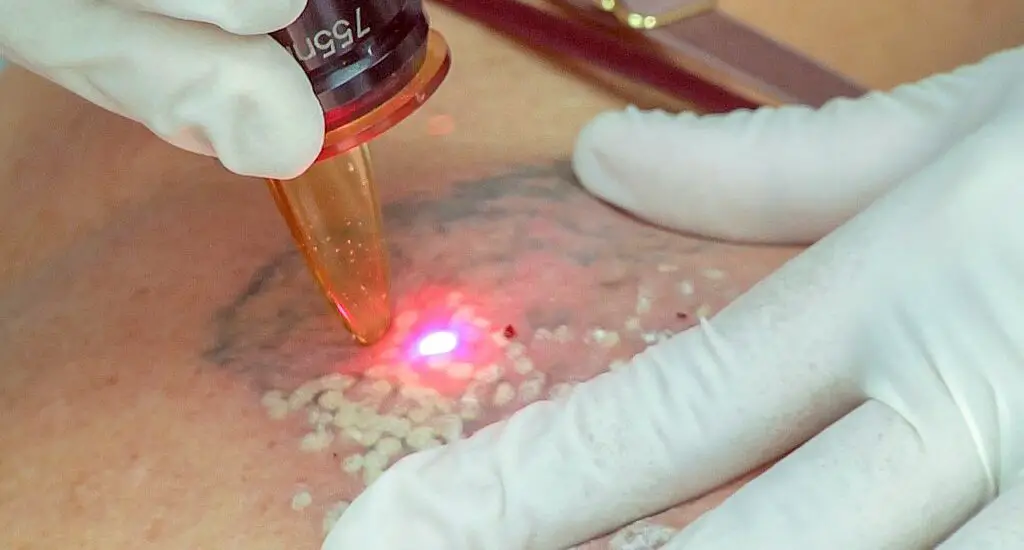If you’re wondering what happens to the skin after laser tattoo removal, this guide provides an in-depth exploration of each stage of the skin’s healing process, post-care tips, and what long-term outcomes you can expect.

Table of Contents
What Happens to the Skin After Laser Tattoo Removal?
During laser tattoo removal, the laser emits short pulses of concentrated light that penetrate the top layers of the skin to reach the tattoo ink. This light energy is absorbed by the tattoo ink particles, breaking them into smaller fragments that can be eliminated by the body’s immune system.
Here’s what happens to your skin:
Redness and Swelling: These are immediate reactions as blood flow increases to the area to start the healing process.
Frosting: This is caused by the rapid heating and expansion of gas and water around the tattoo ink particles, leading to a temporary whitish covering.
Discomfort: You may feel discomfort akin to a rubber band snap due to the intense light pulse. Cooling methods or numbing creams might be used to minimize this sensation during the procedure.
Each skin reaction is temporary and an expected part of the body’s natural healing response. The degree of these reactions can vary based on the individual’s skin type, the laser’s settings, and the location and color of the tattoo.
Caring for Your Skin Immediately After Tattoo Removal
Proper aftercare is vital to prevent complications and to ensure the best possible outcome for your laser tattoo removal. Immediately following the procedure:
Bandaging: A sterile bandage or dressing will be applied by the technician to keep the area clean and protected from potential irritants or infection.
Cleansing: You should gently clean the area daily with fragrance-free soap, patting it dry carefully. Avoid scrubbing or using hot water which can irritate the skin.
Antibiotic Ointment: Application of a thin layer of antibiotic ointment can promote healing and prevent infection. Always apply with clean hands or a sterile applicator.
Reducing Swelling: Use cool packs and keep the treated area elevated to help reduce swelling and discomfort.
Following these immediate post-treatment steps is critical for ensuring your skin begins its healing process in the best condition possible, free from complications like infection or excessive inflammation.
The Detailed Healing Process After Laser Tattoo Removal
The healing process after laser tattoo removal involves several stages, including:
Blistering: Occurs as a result of the skin’s reaction to the laser’s heat, which is a normal part of the healing process and should not be punctured to avoid infection.
Scabbing and Peeling: As the treated skin heals, scabs and peeling can occur. It’s crucial not to pick at scabs or peel to prevent scarring.
Itchiness: As the skin regenerates, it may become itchy. Using a moisturizer approved by your dermatologist can alleviate discomfort, but scratching should be avoided.
Pigment Changes: Hypopigmentation or hyperpigmentation may occur, which can be temporary or permanent. Darker skin tones are more susceptible to these changes.
Each stage of healing requires its own care routine. Generally, keeping the area clean, moisturized, and protected from direct sunlight is essential. Always consult with your laser technician or dermatologist for personalized care instructions.
Check out these other articles…
How to Treat a Tattoo After Laser Removal: Complete Guide
Does Tattoo Continue to Fade After Laser Treatment? Answered
Can You Get a Tattoo After Laser Removal? Detailed Answer
Dry Skin After Laser Tattoo Removal: Essential Care Tips
Skin Discoloration After Laser Tattoo Removal: Easy Guide
Long-Term Skin Care and Maintenance
Once your skin has fully healed from the laser tattoo removal, long-term care is focused on maintaining skin health and monitoring for any late-onset reactions. Here’s what you should do:
Sun Protection: Always use broad-spectrum sunscreen with an SPF of 30 or higher like this Aveeno Protect + Hydrate Body Sunscreen Lotion available at Walmart on the treated area to protect against UV rays, which can exacerbate pigment changes.
Regular Observation: Keep an eye on the treated skin for any signs of abnormal changes such as persistent redness, and consult with a professional if such changes occur.
Sun protection is especially important after laser treatment as the skin is more sensitive to sunlight and more vulnerable to the harmful effects of UV radiation. Regular observation helps catch any potential issues early on.
Setting Realistic Expectations for Tattoo Removal Results
Understanding what to expect from laser tattoo removal is key to a satisfying outcome. Here’s what you should consider:
Complete Removal Not Guaranteed: Some tattoos may only partially fade, and certain colors may not respond as well as others.
Factors Influencing Success: Age of the tattoo, colors used, tattoo location, and your skin type can all affect removal success.
Number of Sessions: Multiple sessions are often required, and the exact number can vary. Your provider can give you an estimate based on your individual case.
It’s important to discuss all these aspects with your treatment provider to align your expectations with the realistic outcomes of the procedure.

